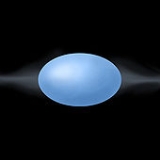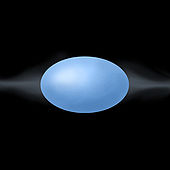
Be star
Encyclopedia

Stellar classification
In astronomy, stellar classification is a classification of stars based on their spectral characteristics. The spectral class of a star is a designated class of a star describing the ionization of its chromosphere, what atomic excitations are most prominent in the light, giving an objective measure...
with prominent emission lines of hydrogen
Hydrogen
Hydrogen is the chemical element with atomic number 1. It is represented by the symbol H. With an average atomic weight of , hydrogen is the lightest and most abundant chemical element, constituting roughly 75% of the Universe's chemical elemental mass. Stars in the main sequence are mainly...
in its spectrum. The designation is combined by the spectral class, B, and the lowercase e denoting emission in the spectral classification system. Line emission from other atomic ion
Ion
An ion is an atom or molecule in which the total number of electrons is not equal to the total number of protons, giving it a net positive or negative electrical charge. The name was given by physicist Michael Faraday for the substances that allow a current to pass between electrodes in a...
s might be present as well, but is typically much weaker. Other observational characteristics include optical linear polarization
Linear polarization
In electrodynamics, linear polarization or plane polarization of electromagnetic radiation is a confinement of the electric field vector or magnetic field vector to a given plane along the direction of propagation...
and often infrared
Infrared
Infrared light is electromagnetic radiation with a wavelength longer than that of visible light, measured from the nominal edge of visible red light at 0.74 micrometres , and extending conventionally to 300 µm...
radiation that is much stronger than in ordinary B-class stars, called infrared excess
Infrared excess
An infrared excess is a measurement of an astronomical source, typically a star, that has a greater measured infrared flux than expected by assuming the star is a blackbody radiator. Infrared excesses are often the result of circumstellar dust and are common in young stellar objects and evolved...
. As the Be nature is transient, Be stars might exhibit a normal B-type spectrum at times, and hitherto normal B stars may become Be stars.
While most Be stars are on the main sequence, the identifier actually refers to a heterogeneous group of objects including pre main sequence stars
Young stellar object
Young stellar object denotes a star in its early stage of evolution.This class consists of two groups of objects: protostars and pre–main sequence stars. Sometimes they are divided by mass - massive YSO , intermediate mass YSO and brown dwarfs....
, supergiant stars, protoplanetary nebulae, and others. They may be subclassed into B[e] supergiants, Herbig Be stars, compact planetary nebula B[e
Planetary nebula
A planetary nebula is an emission nebula consisting of an expanding glowing shell of ionized gas ejected during the asymptotic giant branch phase of certain types of stars late in their life...
], symbiotic B[e], and a catch-all "unclear" category.
The first star recognized as a Be star was Gamma Cassiopeiae
Gamma Cassiopeiae
Gamma Cassiopeiae is an eruptive variable star, whose brightness changes irregularly between +2.20 mag and +3.40 mag. It is the prototype of the Gamma Cassiopeiae variable stars. Although it is a fairly bright star, it has no traditional Arabic or Latin name...
, observed 1866 by Angelo Secchi
Angelo Secchi
-External links:...
, the first star ever observed with emission lines. With the understanding of the processes of emission line formation in the early 20th century it became clear that these lines must come from the circumstellar environment, not from the star itself. Nowadays, all the observational characteristics are explained with a gaseous disk that is formed of material ejected from the star. The infrared excess and the polarization result from the scattering of stellar light in the disk, while the line emission is formed by re-processing stellar ultraviolet light in the gaseous disc.
Be stars are generally acknowledged to rotate rapidly, which has been confirmed by interferometric measurements of the rotational distortion of Achernar
Achernar
Achernar , sometimes spelled Achenar, is the brightest star in the constellation Eridanus and the ninth-brightest star in the night sky. Of the top ten apparent brightest stars —Sirius, Canopus, Alpha Centauri, Arcturus, Vega, Capella, Rigel, Procyon, Achernar and Betelgeuse—Achernar is the hottest...
. However, rotation alone is probably not sufficient to form the disk, but an additional ejection mechanism is required, such as a magnetic field or nonradial stellar pulsation. The transient nature of the Be phenomenon is most likely connected to the nature of that secondary process, but the details are currently still being discussed.
Be stars are typically variable and can either be classified as Gamma Cassiopeiae variable due to the transient nature of the disk and the scattering processes, or as Lambda Eridani variable
Lambda Eridani variable
A Lambda Eridani Variable is a class of variable stars that show small, irregular variability on short time scales. Achernar is an example.-References:*...
on account of their pulsational nature.
External links
- Philippe Stee's homepage: Hot and Active Stars Research
- Article from Olivier Thizy: Be Stars

